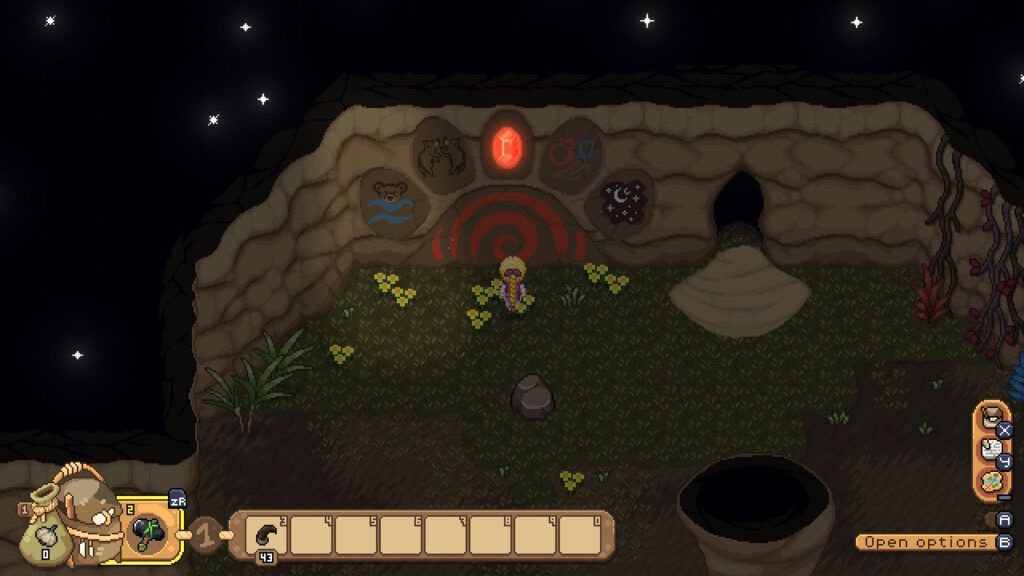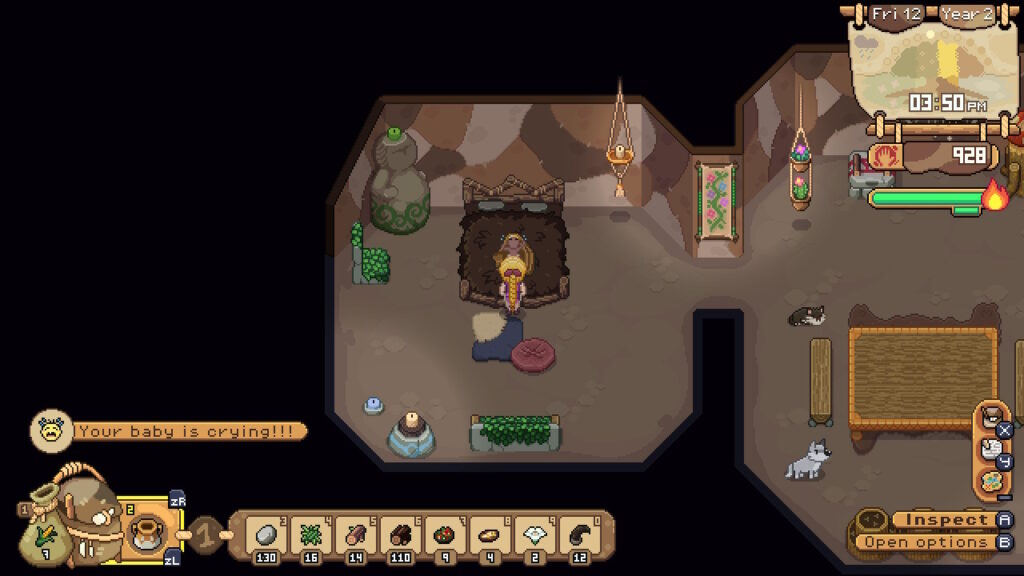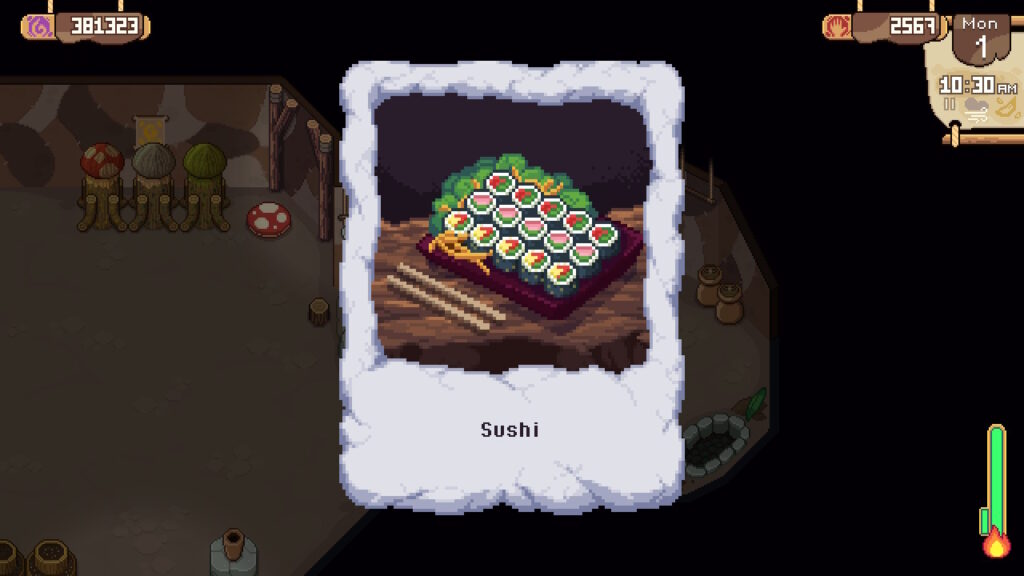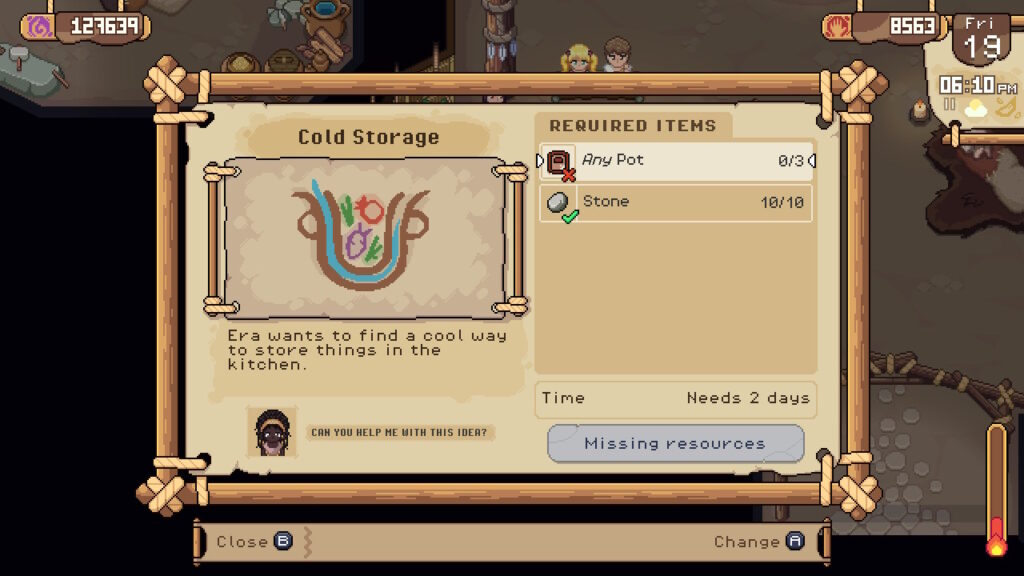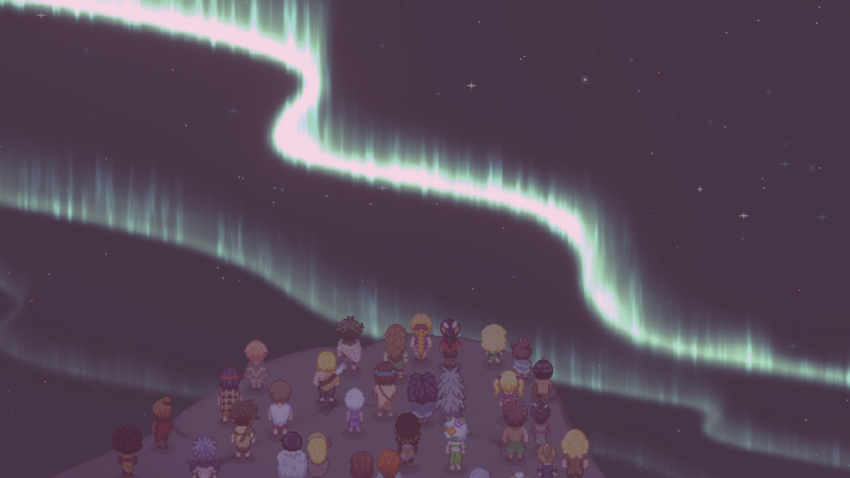Welcome to my Roots of Pacha review. We were not given a review code for this title.
Roots of Pacha has been lauded as “Stardew Valley in the stone age,” but it’s so much more than that. Roots of Pacha is an innovative farm and life sim set in the stone age with a wholly unique take on currency, building, and what constitutes “progress.” Developer Soda Den struck a perfect balance between keeping intact the essential elements I love about farming sims and blending in some new, unique ideas that have the potential to refresh the genre all together.
This review may contain minor spoilers for gameplay and story beats, though I always try not to reveal any major plot twists or surprises.
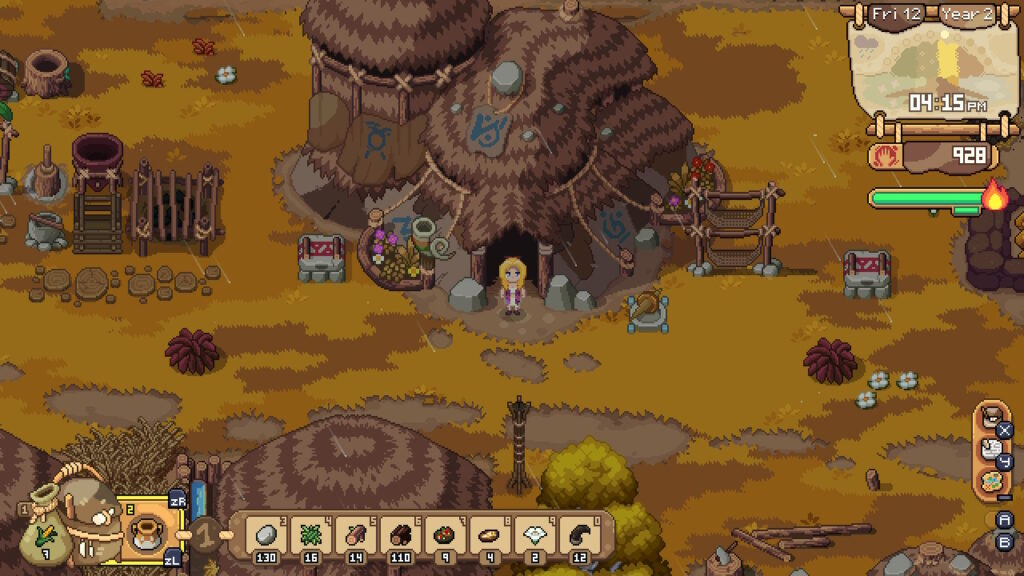
First Impressions
I first played Roots of Pacha back in summer 2023 on Steam. At that time, I didn’t have this blog, I was just hungry for my next farming sim experience (as always). I didn’t get that deep into it, as PC isn’t my preferred place to play (2024—Steam Deck, here I come!). When Soda Den dropped Roots of Pacha on Nintendo Switch (and other consoles) in November 2023, I was both feeling ready to complete the game and had somewhere to write about it.
The reason why it was important I have somewhere to write about Roots of Pacha is because the game shakes up the “farming sim” formula in so many interesting and invigorating ways that I had to talk about it. Right off the bat, you’ll see that instead of “currency” you contribute to your clan and earn “prosperity” points that can be “traded” for goods and services. Of course, in the stone age, community is paramount. And money doesn’t exist. And Roots of Pacha plays with these elements so, so well.
Instead of shopping, you forage and gather seeds. Instead of buying at a ranch, you collect wild animals by taming them with song. You start out with a single tool—a sharp rock—and by contributing to your clan you unlock “ideas” (inventions) that eventually beget an ax, a hoe, a spear, a pickaxe.
Festivals are novel and unique, with just a touch of “minigame-isms” without getting dull or convoluted or redundant. You will paint your story on cave walls, play instruments with rival crews, battle it out with tug-of-war on the beach. Roots of Pacha doesn’t try to do the farming sim genre “bigger,” they try to do it better—and for the most part, they succeed.
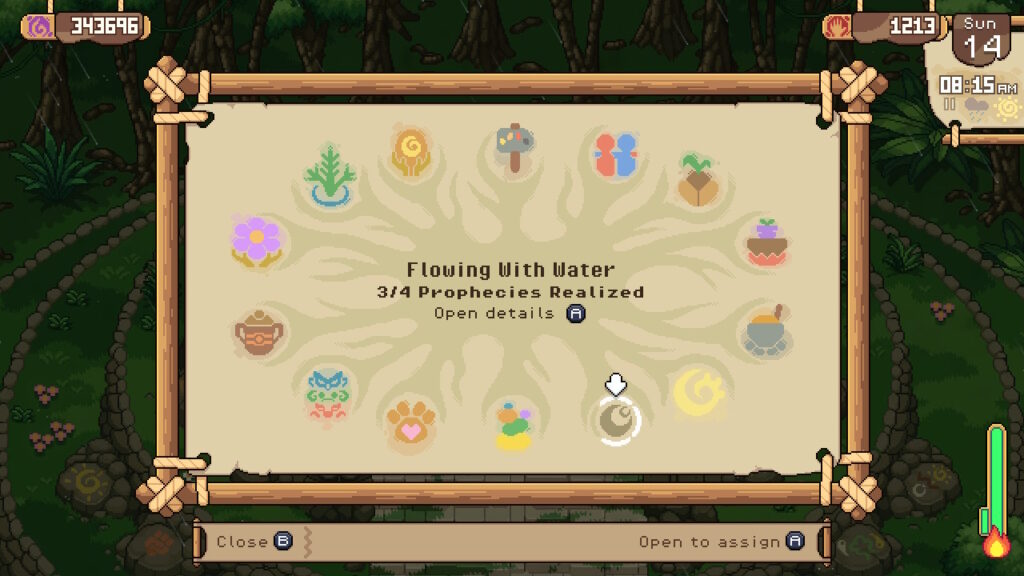
Characters & Story
The story guiding Roots of Pacha is charming, unique, and yet…a tale as old as time. Warring tribes, rival families. You can probably guess the gist of it. As a part of the Pachan tribe, recently settled in a new land following a shamanic prophecy, you find yourself caught between rival clans: the Mograni to the north, and the Yakuans to the south. Each worships fire and water respectively. Destined to clash.
You will spend most of your time among your own clan, the Pachans, with the leader Gin, the shaman Vuak, the healer Ada, the storyteller Tetih, and the likes. But every so often these clashing neighboring clans will visit, either in the savannah to the north or on the beach to the south. You will soon learn of a prophecy, and a message—the deity Pacha wants you to do something, but what? You must embark on a series of quests to unveil her path for you.
These “quests” are actions that you must take, through daily tasks like farming and exploring. It’s a unique take on the “bundles” storyline format of games like Stardew Valley and Sprout Valley. Yes, you still complete “bundles”—but each “bundle” is comprised of actions and accomplishments rather than items. Each element is introduced by a riddle. “The plants they grew took a more domestic shape” might expect you to level up your crop quality or “They proudly named the many plates they made” might require cooking various dishes at the hearth. As you complete the tasks required, more and more of the story will be revealed.
Where did the Mograni and Yakuan clans come from? Why do they share such disdain for one another now? And is this the way it always must be, filled with division and prejudice? The tale is simple but poignant. The primary narrative can be completed in about 40 hours if you hustle. But why rush it? There is plenty to do outside of what unlocks the next story beat.
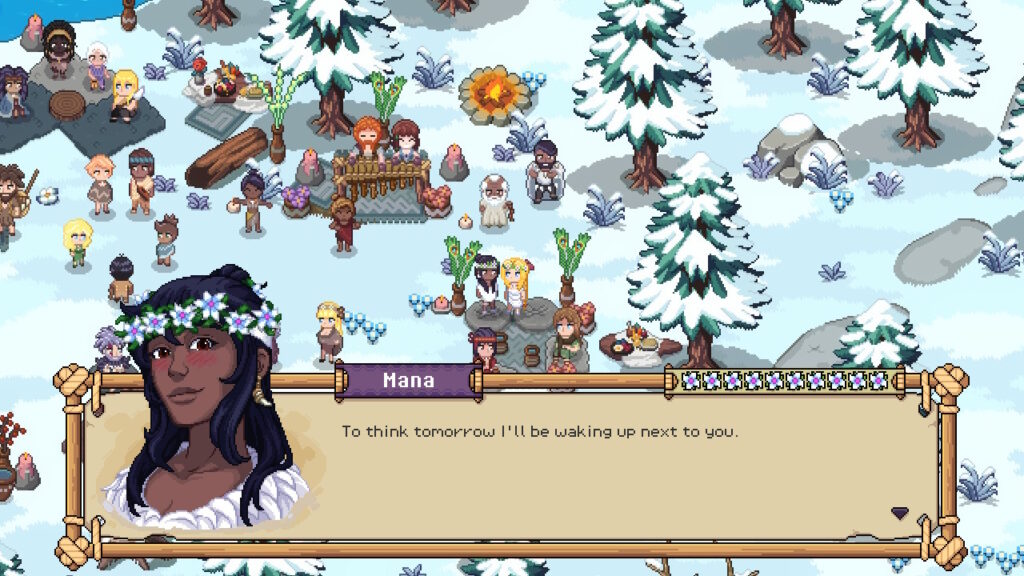
Like many well-defined farming/social sims, the real treasure is in the character stories. There are over a dozen marriage candidates in the game and you are free to date all of them, regardless of gender or relationship status. Polyamory is welcomed in the clan, although you can only commit to a Union and start a family with one person. So feel free to lean into any and all character stories/romances that you fancy because this is key to the game’s storytelling strength.
Roots of Pacha manages to keep the character side stories fresh yet relatable. Obviously, stone age life is going to have different ups-and-downs than we are used to in modern day—but the game does a good job grounding them in experiences and emotions that are still familiar. Feeling like an outsider, the pressure of family expectations, fear of abandonment, and sibling jealousy are a few examples of themes that popped up here.
The novelty of prehistoric socialization does lose its novelty outside of dating. Some of the throwaway lines about “How does the river water return to the sky” or “I need to pick a role between hunting or gathering” can get kind of trite. It’s such a clever setting for a farming sim but I can see how it would be a struggle to keep dialogue contextually relevant and interesting to the player. I would say the game nails it about two thirds of the time, which is honestly impressing considering the challenge.
Besides that (honestly minor) consideration, Roots of Pacha boasts a diverse cast of weirdly relatable prehistoric characters and a story mostly washed clean of tired farming sim tropes (dead grandparent’s farm, anyone?). In the best way possible, Roots of Pacha invites players and future game developers alike to re-imagine the genre in new and exciting ways.
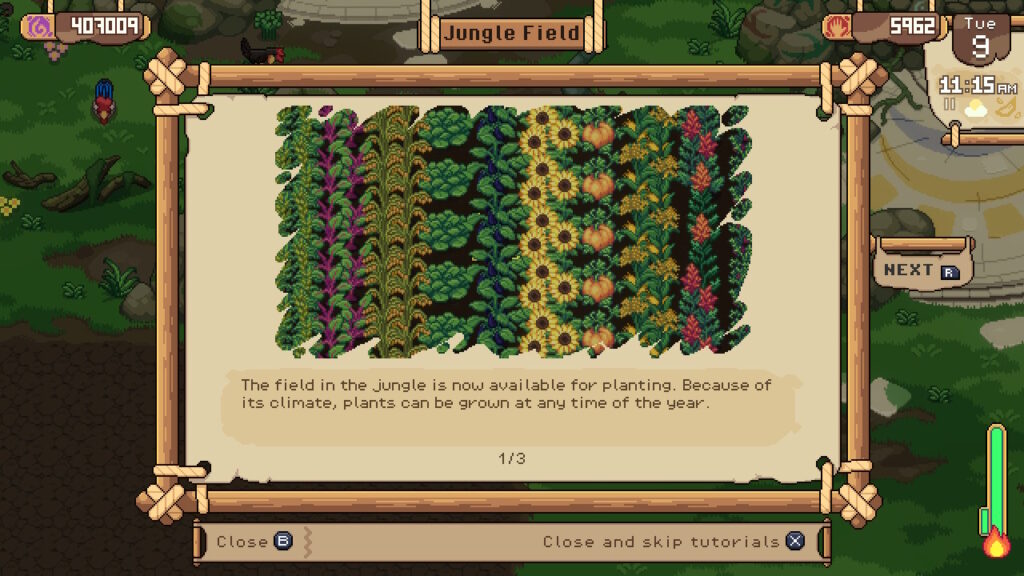
Gameplay Loop
Roots of Pacha’s gameplay loop will feel familiar to most farming sims aficionados—with a few tweaks to keep things fresh. Exploration and gathering is instrumental, as that is how you will find crop seeds and animals to tame. The game starts pretty boxed in but soon you will open three distinct biomes: forest/mountain, beach, and savannah. Each houses different plant and animal life, as well as extra forigables: mushrooms, herbs, bones, shells.
Seeds can be planted in your fields, which, granted, are quite annoying to keep clean. Weeds and rocks re-sprout every season, so it’s probably not worth clearing everything out every time. But once you start planting, watering, and harvesting crops you will gain knowledge points about different fruits and vegetables. This will increase the quality of future seeds and plants. You essentially have your hand in the evolution of the first crops, for example, and can work towards developing forms more recognizable to us today in modern times.
It’s a satisfying and interesting flow, and makes the player connect with the game world in ways that might otherwise be glossed over. Slowly, you will unlock new tools to make your life easier: starting with a sharpened rock and ending with the typical farming sim assortment—with some cool twists sprinkled in, like a spear instead of a fishing rod and an irrigation system rather than sprinklers.
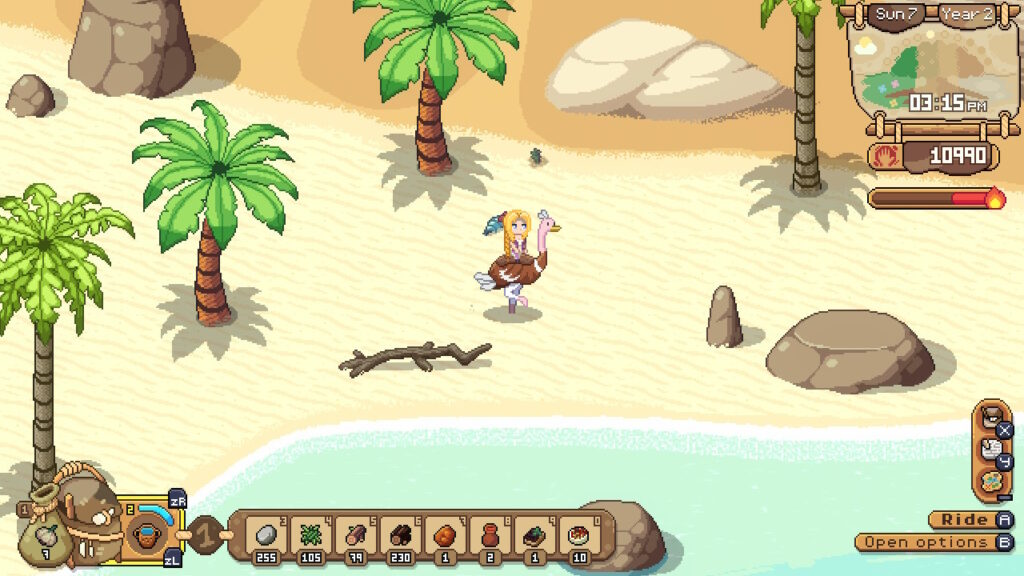
Eventually you’ll have animals, which provide resources like eggs, milk, feathers, and fur. They can breed to produce offspring with better stats, like speed for mounts. You can release them or turn them into meat, as the cycle of taming and re-taming wild beasts will eventually spawn rarer types of animals within each herd. You can choose a mount and race it every Saturday (once you’ve invented days of the week, that is) or call it to you using conveniently placed horns in each biome.
As you work to develop the clan and get to know the folks in it, different people will have ideas to make new devices or tools. If you can satisfy their requests, you’ll be rewarded with processing machines to dry produce or pickle it, juice it, pummel it, and so on. By collecting items and contributing them to the clan, you will gain prosperity and unlock new tools, inventions, shops, and decorations. You can “shop” for things like housing decor and outfits by “cashing in” some of the Prosperity you have contributed and collected.
Getting to know people will not only unlock new inventions but can also spark side stories, friendships, and even romances. There are a plethora of bachelors and bachelorettes to choose from and courting is made particularly easy. You can gain friendship points mostly by talking to clanfolk every day, though a liked or loved gift here or there doesn’t hurt.
After your Union, you can have up to two offspring with your partner by praying to the statue by your marital bed. The only reason I bring this up is because Roots of Pacha has a hands-on approach to raising progeny, something I haven’t seen much in games beyond the player interacting with their child to earn friendship points. Between the hours of 3-4PM (after you’ve invented time and the sundial, of course) your newborn will fuss. You can feed them, change them, and/or rock them to sleep. Doing so will influence your relationship as they grow. Ignoring them when they call for you may have consequences later on. This is yet another example of how the game tries to think outside of the box while still delivering all of the cozy farming/life sim elements that you know and love.

What will guide your day-to-day are the “bundles” I mentioned in the section above. Decipher the riddles and chase the achievements to move the main plot forward (and be rewarded with stat-boosting items). This will eventually lead to the cave system in the mountains, which has its own set of challenges and tricks. Three spirit guardians will “test” you with a series of trials, collection quests, and puzzles.
The cave system is probably the most unique element of Roots of Pacha as far as gameplay mechanics are concerned. There is no combat and you progress by breaking rocks until you trigger the release of hidden doors. Eventually you’ll get a map of the space and trust me when I say you’ll want to explore every inch of it. From gemstones and new powers, secret animal packs and a wealth of material stone, you will find many riches buried deep within the maze.
You will also, eventually, stumble across the “trials” themselves. These are environmental puzzles that feel old world Legends of Zelda-esc in their approach to guiding beams of light, moving statues, triggering switches in the right order, and solving puzzles with a new power granted to you in each area. You’ll fly, jump, and smash your way through the catacombs as an owl, monkey, and bear—though these powers don’t have a ton of utility outside of the trials.
In this way, Roots of Pacha not only gives players a completely new take on farming sims but they also inject unexpected elements of puzzle gaming. Roots of Pacha is the kind of game I would recommend even to cozy gamers who are all farming sim’ed out, as it adds so many new layers to the genre.
The bad news is that it is a bit content-lite compared to some farming sims. The good news is the Roots of Pacha devs have a killer roadmap with insanely high ambitions, like the ability to visit other clans and a deep animal husbandry system. If you are someone who one-and-dones most games, I might hold off playing it until a few more milestones have been reached. But if you are the kind of gamer with 1000+ hours logged in Stardew Valley (me), then I would heartily recommend getting in on the ground floor, supporting what the devs are doing with your dollars, and enjoy watching the game flesh out in real time.
Update: Roots of Pacha v1.3 is live now, with new areas, festivals, and an evolution mechanism.
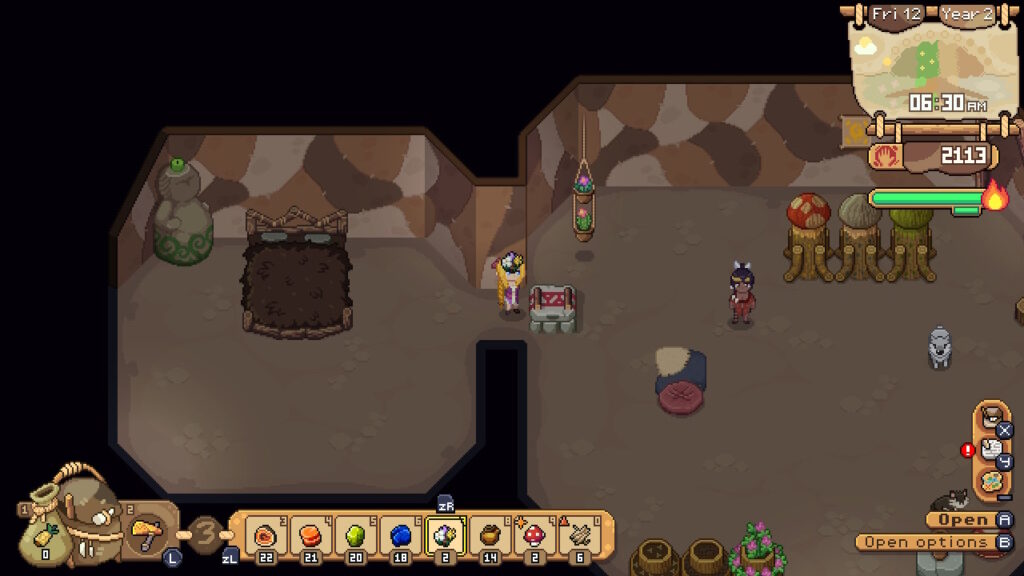
Technical Issues
For me, Roots of Pacha was pleasantly issue free for most of the game. Here are the few things I did notice at the time of writing this:
- The game froze (black screen) at one point when I entered the savannah in the rain with a mount
- Upgrading your house can block you in the bedroom if chests are positioned a certain way

Summary
Who has time to read whole game reviews these days? Here’s the TLDR so you don’t leave empty-handed.
Pros
- Unique take on a well-worn genre
- Tons of free content on the roadmap
- Genuinely fun and fresh cast of characters
- Delightful and engaging puzzles and riddles throughout
- No combat (if you aren’t into that usually)
Cons
- May feel content-lite to some
- Character dialogue isn’t always relatable given the time period
- No combat (if you are into that usually)
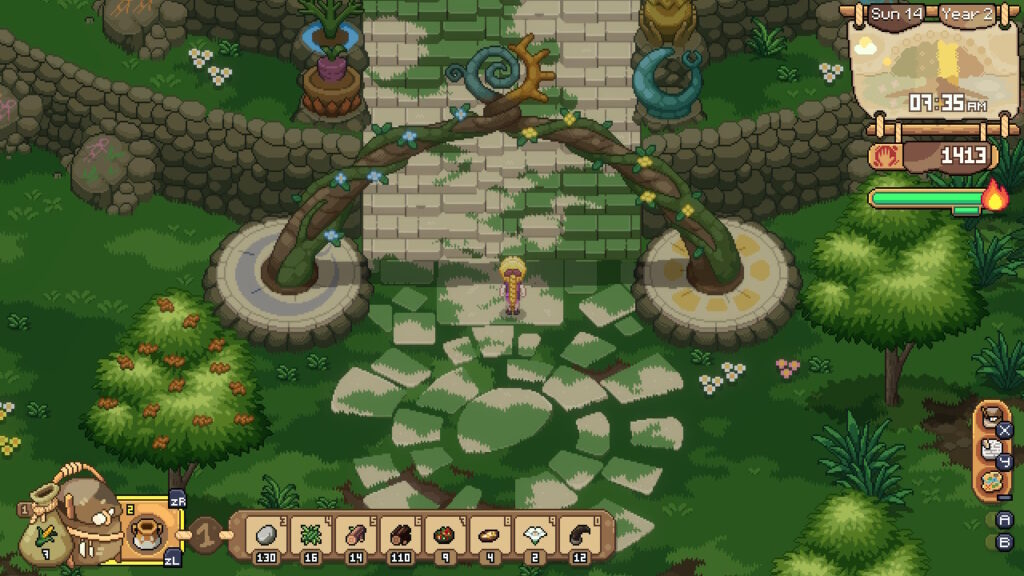
Conclusion
Roots of Pacha is both a love letter to farming sims and a revitalizing, experimental take on a well-worn genre. Cozy gamers will love the blend of exploration, resource management, social simulation, and puzzles—a mix that ensures the days never get too repetitive or boring. The cast of characters find a way to be loveable and engaging despite the sprawling eras separating our lives from theirs. In conclusion, Roots of Pacha is a game about collective unity over rugged individualism—something the world could use a lot more of these days.
I would recommend buying Roots of Pacha at full price, if my review appeals to you at all. Let’s support devs who make a great product with ongoing free updates!
Who Roots of Pacha is for…
- Farming sim fans looking for something fresh for the genre
- Cozy games who might like a farming x puzzle genre mashup
- Those who don’t enjoy combat in their cozy games
Who Roots of Pacha is not for…
- Players who want modern or more realistic storylines
- Folks who don’t enjoy puzzles or riddles
- Those for whom earning and spending currency is a core part of the fun
Stay cozy, gamers!
